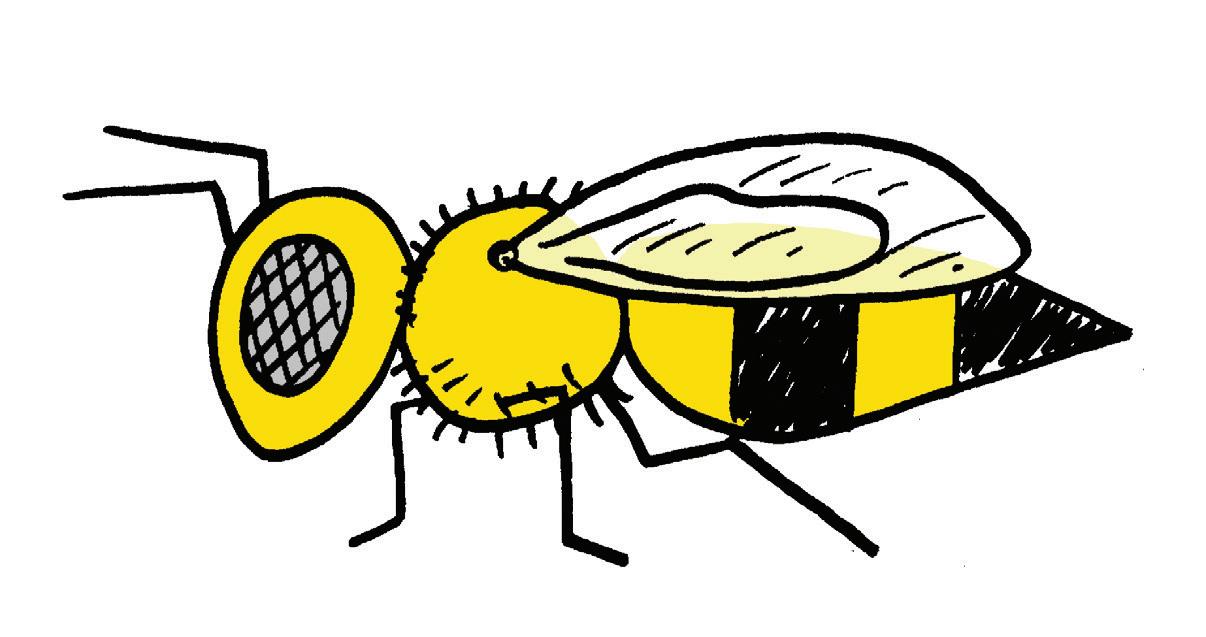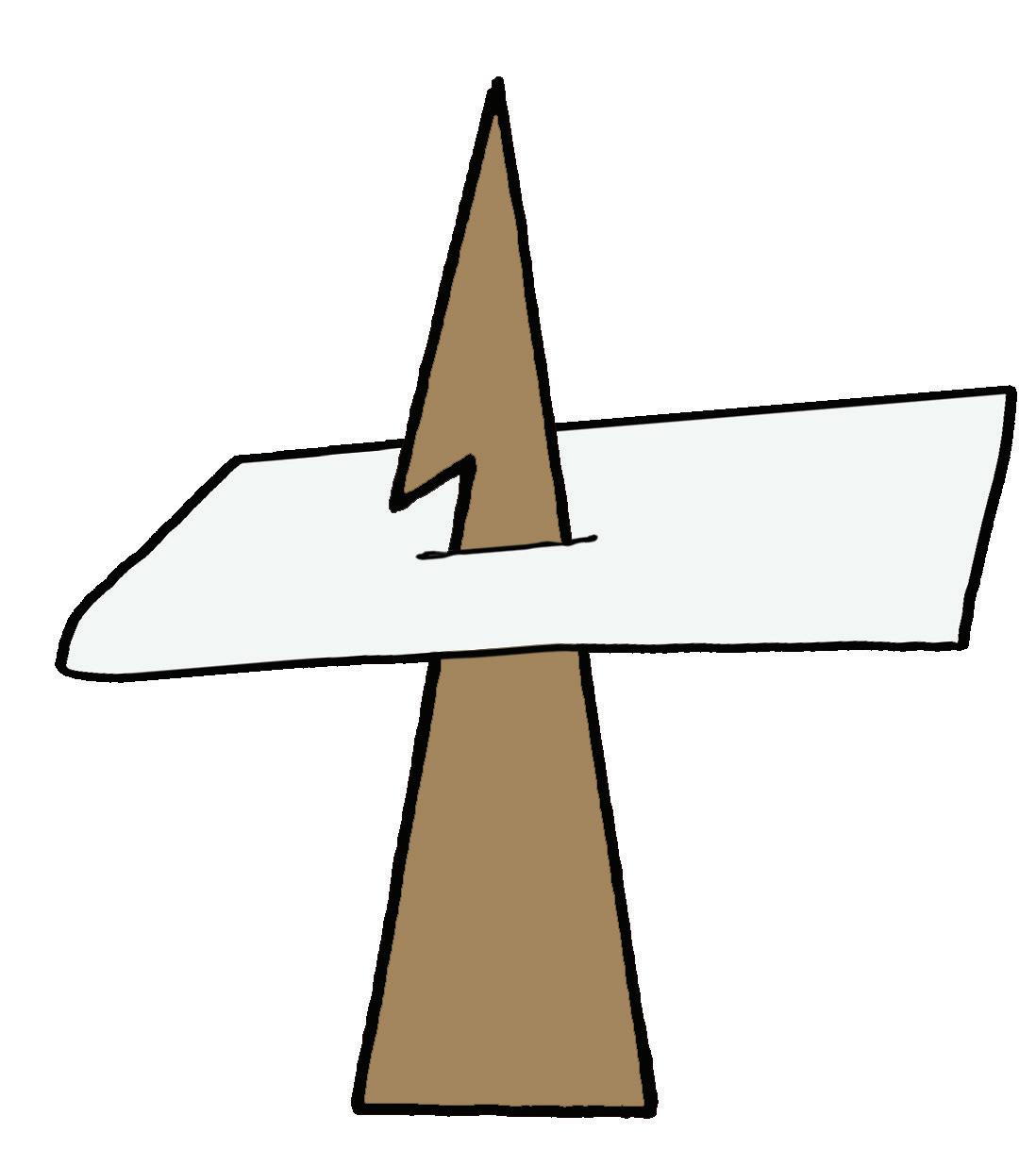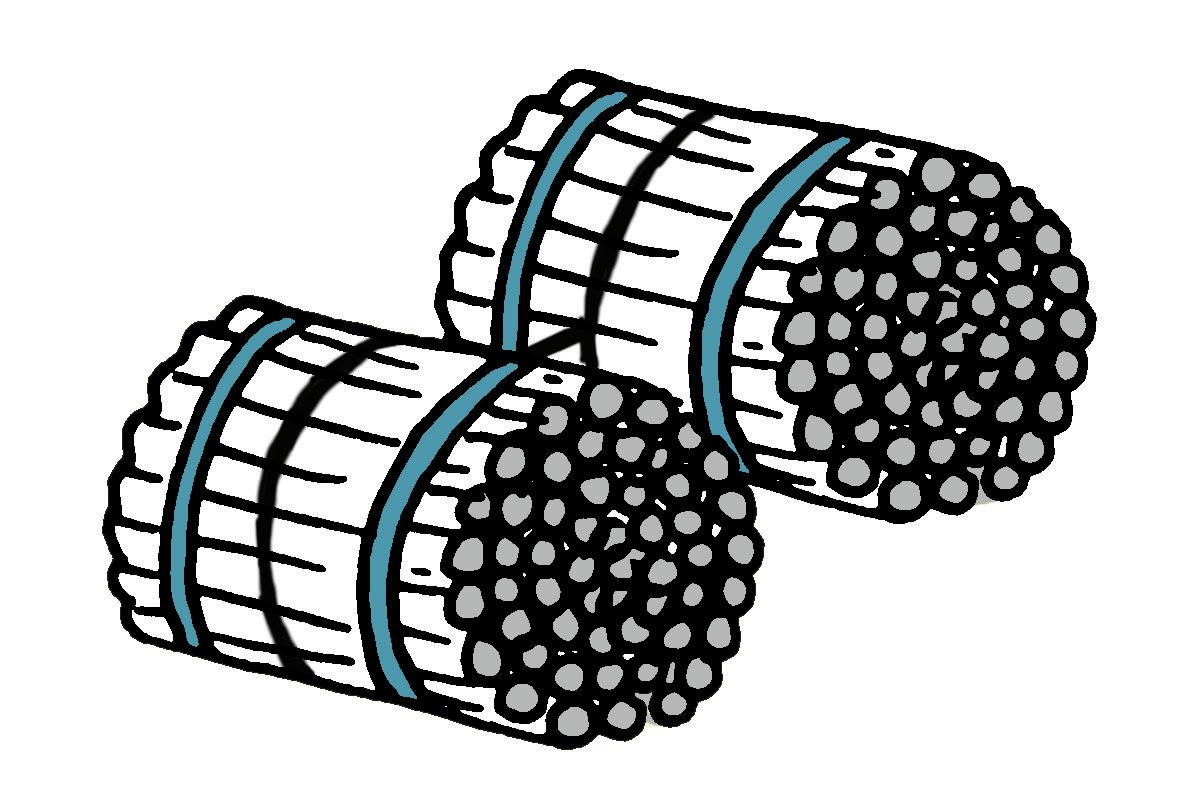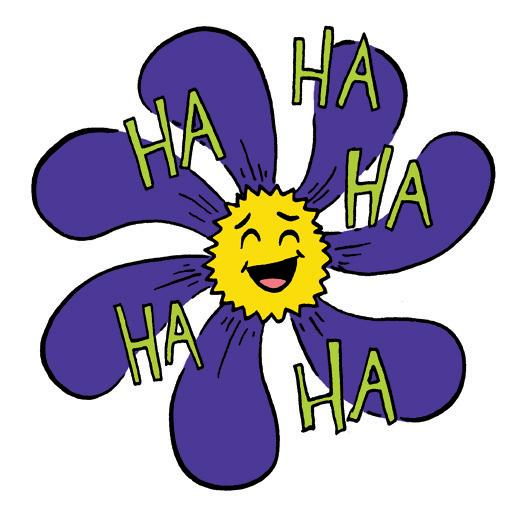
15 minute read
On the inside part of the
5Draw a big oval in the middle of the head for one compound eye. Add crisscrossing lines to show lots of facets.
6Draw three lines from top to bottom on the abdomen for a bull’s eye pattern that points to the stinger. Is your bee male or female?
7Draw two backward L’s on the top of the head to make the antennae and three Z shapes on the bottom of the thorax to make your honey bee’s jointed legs. Use little lines to add fuzz.
8Ink over your pencil lines and erase any lines you don’t want. Color your honey bee.


TRY THIS! Use these directions to draw some other insects. What do you notice is similar about these insects? What is different? How is drawing a honey bee useful to studying anatomy?
THE CYCLE OF LIFE
Watch a honey bee in its four stages of metamorphosis! Which stage do you think is the safest for the bee? Which is the most dangerous? How does the bee change its looks in each stage?
BEE BUZZER
Honey bee wings make a buzzing sound when they move quickly. You can make a similar buzzing sound by blowing air through this bee buzzer!
1Decorate one side of each craft stick.

2Trace one craft stick on the paper. Use your scissors to cut it out on the inside of the lines, so the cutout is a little smaller than the sticks.
3Snip off two pieces of the toothpick about the same size as the width of the craft stick.
SUPPLIES * 2 craft sticks * crayons or markers * pencil * paper * scissors * toothpick * 2 rubber bands * Bee Journal
4Put the piece of paper on the uncolored side of a craft stick. Put one piece of the toothpick on top of the paper near one end.
5Put the other craft stick, uncolored side down, on top of the toothpick and paper, and wrap a rubber band around the stack at that end to hold it in place.

6Slip the other toothpick piece under the piece of paper on the other end of the craft stick and wrap another rubber band around that end.
7Hold the long edge of the craft sticks near your lips. Blow hard through the edge just as you would blow into a harmonica. What happens to the paper? What sound does it make?
TRY THIS! Try different types of paper between your craft sticks. What happens when you use really thick paper? Construction paper? Waxed paper? Record your results in your Bee Journal.

bee milk: a liquid food made by worker bees to feed to larvae. WORDS KNOW to
YOU ARE WHAT YOU EAT
Have you heard the saying, “You are what you eat?” This is especially true for honey bees. For the first three days, all larvae are fed royal jelly. After that, most will get fed bee bread or bee milk. If the bees want to make a new queen, they continue to feed a few special larvae just royal jelly. The royal jelly helps the larvae grow bigger and faster, and they will all become queens. One of them will survive to rule the hive.
BARBED STINGER
Have you ever gone fishing? Many fish hooks are barbed, just like a honey bee’s stinger. Barbs help the hook stay in the fish’s mouth. How do barbs work?
1Use your pencil to draw a very long, skinny triangle with a pointy tip on your cardboard. This is like a queen’s stinger.
2Now draw a long, skinny triangle with a half-arrow as its tip. This is like the barbed stinger found on a worker bee or a barbed hook found on a fishing line.
3Carefully cut out each stinger.
SUPPLIES * small piece of cardboard * pencil * scissors * tissue paper * Bee Journal
QUEEN WORKER
4Label the colored area of an empty page in your Bee Journal, “Stinger Tests.” Which stinger do you think is going to go through and be removed from the tissue paper more easily? Write down in your journal what you think will happen.


5Poke the straight stinger through the tissue paper until there is half on each side. Gently pull it out.
6Do the same thing with your barbed stinger. What happens? Which stinger comes out more smoothly?
7Compare the holes made by each type of stinger. Is one larger than the other? Did the tissue paper ever tear? Write or draw your observations in your Bee Journal.
TRY THIS! What else can you poke your cardboard stingers through? Is there any material that is so thick you can’t get the barbed stinger out again? Not all striped insects are honey bees. Other bees, wasps, beetles, moths, and some flies also have striped abdomens. Many of them visit flowers as well. It is safest to watch all insects from a distance to avoid getting stung. D I D Y O U K N O W ?
METAMORPHOSIS MAGIC
Honey bees live through four very different stages. With this activity, you can watch a bee go from egg to larva to pupa to adult, simply by flexing your folds.
1Fold each corner of the paper to the middle. It should look like four even triangles.
2Turn the paper over. Fold each corner of the paper into the middle. It should look like there are eight even triangles, but they are all in sets of two.

3Lift up each set of two and draw a picture of a different life stage of the honey bee (egg, larva, pupa, adult) in each area.
4On the inside part of the triangle that folds over the picture, write a fact about each life stage. For example, “Honey bee eggs hatch after three days.”


SUPPLIES * square piece of paper, 8½ by 8½ inches * crayons or marker
5With the triangles folded over the pictures, flip the paper over so you see four squares. Write the names of a different life stage (egg, larva, pupa, adult) of the honey bee on each square.

6Fold the paper on the lines between the squares. Push up on the corners until you can fit your thumbs and first two fingers into the flaps under the squares.

7Practice pushing your thumbs and fingers together and apart to make it work.
8Can your friends and family guess what life stage is under each clue?
AMAZING METAMORPHOSIS
Honey bees go through complete metamorphosis. This means there are four very different parts of their life cycle. Some insects, such as grasshoppers, go through incomplete metamorphosis. These insects never become a pupa. They just change little by little as they grow into an adult. You can watch a short movie about these two types of metamorphoses here.
SEE LIKE A BEE
Honey bees have lots of facets in each compound eye. Each facet sees things just a little bit differently. In this activity, you’ll make a set of glasses that will let you see how a honey bee sees!
SUPPLIES * 15 thin drinking straws * scissors * 2 rubber bands * 3 pipe cleaners
1Cut each straw in half. Divide the straws into two equal groups.
2Wrap a rubber band around each bundle to hold the straws together.
3Wrap one end of a pipe cleaner around one bundle and the other end around the other bundle, leaving a 1- or 2-inch space between bundles. This space will sit on top of your nose.

4To attach your honey bee eye glasses to your face, wrap one end of a pipe cleaner around each bundle. When both bundles are ready, lift them up to your eyes and wrap the free end of each pipe cleaner over an ear. Now you can see like a bee!
TRY THIS! Because of their compound eyes, honey bees see in a mosaic. A mosaic is a picture made up of lots of pieces of color that look separate when you’re close to them but blend to show an image when you move back. Make your own mosaic picture by putting a dot of color in each square on a piece of graph paper. How does it look up close? How does it look far away? How does it look through your bee eyes?
abdomen: the section of an insect farthest away from the head. adapt: changes a plant or animal makes to survive in its environment. anatomy: the body parts of an animal. antennae: feelers found on the head of insects and some other animals. One antenna, two or more antennae. anther: the part of a flower that makes and holds the pollen. archaeologist: a scientist who studies things made and used by people who lived long ago. atmosphere: the blanket of air surrounding Earth. barb: a sharp point going backward off another sharp point, such as on an arrow or a fishhook. BCE: put after a date, BCE stands for Before Common Era and counts down to zero. CE stands for Common Era and counts up from zero. These non-religious terms correspond to BC and AD. This book was printed in 2015 CE. bee bread: a mixture of pollen, bee spit, and nectar.
bee milk: a liquid food made by worker bees to feed to larvae. beekeeper: a person who raises bees. beeline: a straight line from one place to another. beeswax: wax made by bees that is used to make candles and other useful things. brood: all the eggs, larvae, and pupae in a beehive. cavity: an empty space inside a solid object. characteristic: a feature of a person, place, or thing, such as blue eyes or curly hair. chemical: a substance that has certain features that can react with other substances. climate: the average weather in an area during a long period of time. climate change: changes to the average weather patterns in an area during a long period of time. cocoon: a covering that some insects make around themselves to protect them while they grow.
colony: a group that lives and works together. communicate: to share information in some way. compound: made of many smaller parts. continent: one of Earth’s largest land areas. drone: a male honey bee. drought: a long period of time without rain in places that usually get rain. emerge: to come out. environment: a natural area with animals, plants, rocks, soil, and water. enzyme: a natural chemical that causes a reaction. evaporate: when a liquid heats up and changes into a gas, or vapor. filament: the thin stalk inside a flower that holds up the anther. forage: to collect food in the wild. habitat: the natural area where a plant or animal lives. hexagon: a shape with six equal sides. hive: the place where bees live, lay eggs, and make food.
85
honey bee: a bee that makes honey. honeycomb: a group of wax cells with six sides. Honey bees build honeycomb in their hive. hypothesis: a prediction or unproven idea that tries to explain certain facts or observations. insect: an animal that has three body parts, six legs, and its skeleton on the outside of its body. Many insects have wings. Grasshoppers, ants, ladybugs, and honey bees are all insects. invader: someone who enters a place with force. larva: a young insect that has just hatched out of its egg and looks like a worm. Plural is larvae.

manage: to be in charge or take care of something. mate: to reproduce to make something new, just like itself. To make babies. metamorphosis: the four major changes an insect goes through— egg, larva, pupa, adult. meteor: a rock or chunk of ice that falls toward Earth from space. Small meteors burn up before they reach Earth and we see them as shooting stars. meteorologist: a scientist who studies weather and makes predictions about it. mimic: a plant or animal that looks like another plant or animal. native: a plant or animal that is naturally found in a certain area. nectar: a sweet fluid made by flowers that attracts insects. orbit: to move in a constant circle around something. organic: food grown naturally, without chemicals. ova: the eggs of a flower. ovary: the sac that holds the ova at the bottom of the style in a flower.
peripheral: the area to the side. pheromone: a special chemical made by animals that changes how other animals behave. pistil: the female parts of a flower, including the ovary, stigma, style, and ova. pollen: a powder made by flowers that is needed for the flower to make a seed. pollinate: to transfer pollen from the male parts of flowers to the female parts so that flowers can make seeds. proboscis: the sucking mouthpart of honey bees and some other insects. property: a characteristic of something. The way something is. propolis: a sticky glue made by bees using tree resin. pupa: a stage in an insect’s life cycle when it changes from a larva into an adult. Plural is pupae. queen bee: a bee that is larger than the other bees in the hive. The queen bee lays the eggs. regulate: to control or to keep steady. resin: a sticky liquid made by trees.
resistant: not affected or harmed by something. royal jelly: a special food honey bees make to feed to the young bees. scarce: when there is very little of something. social: describes animals that live in groups, rather than alone. spiracle: a hole in the side of an insect’s body that lets air in and out. spoil: to rot and become dangerous to eat. stamen: the male parts of a flower, including the filament, anther, and pollen.
stigma: the somewhat flat, sticky pad found on top of the style in a flower. stinger: a sharp point at the end of some insects’ bodies. style: the tube in a flower that goes between the stigma and the ovary. super: a special box with no top or bottom that is used to hold frames of honeycomb. swarm: a ball-shaped group of honey bees moving to a new hive. thorax: the middle section of an insect, where the legs and wings attach.
threat: a person or thing that can cause danger or damage. ultraviolet: a kind of light with short wavelengths. It can’t be seen with the human eye. venom: poison given off by some animals and insects. waggle dance: a dance in the shape of a figure eight that honey bees do to tell each other where the flowers are. water vapor: water as a gas, such as steam, mist, or fog. worker bee: a female bee that does all the work in a hive.
METRIC CONVERSIONS
Use this chart to find the metric equivalents to the English measurements in this book. If you need to know a half measurement, divide by two. If you need to know twice the measurement, multiply by two. How do you find a quarter measurement? How do you find three times the measurement? English Metric
1 inch 2.5 centimeters
1 foot 30.5 centimeters
1 yard 0.9 meter
1 mile 1.6 kilometers
1 pound 0.5 kilogram
1 teaspoon 5 milliliters
1 tablespoon 15 milliliters
1 cup 237 milliliters
What did you have for breakfast this morning? Toast, cereal, juice, and fruit? You can thank the honey bees! About one out of every three mouthfuls we eat is affected by honey bee pollination. In Explore Honey Bees! With 25 Great Projects, young readers learn about honey bee colonies, why honey bees live in hives, how honey bees communicate with each other, and why they are so important to human lives. Explore Honey Bees! offers a glimpse into the fascinating and efficient miniature world that children will find familiar from movies such as the 2007 animated Bee Movie. Activities include designing a hive, learning bee dance moves, and making a model of a flower’s reproductive system, which reinforce the math, engineering, and science skills readers gain from the text. Fun facts and colorful illustrations make learning fun and exciting. Links to online primary sources integrate a digital learning experience and offer opportunities to delve deeper into the world of honey bees. W H A T B E E K E E P S Y O U H E A L T H Y ? V i t a m i n B e e !

AGES: 7–10 GUIDED READING LEVEL: P
“Explore Honey Bees! is great for studying science and nature, and I love that you can intertwine lots of different subjects into honey bees and do units on math, history, language arts, vocabulary, and art. As a homeschooler and parent, I would buy this book. Two thumbs up to Nomad Press!”
—Shara Buffington, homeschooling parent and beekeeper
“The kid-friendly, hands-on activities in this book provide a great way to learn more about the honey bees flying through your neighborhood.” —Sue Heavenrich, writer and educator
“This book articulates well the value of honey bees and our society’s dependence upon them.” —Darren Cox, President, American Honey Producers Association
“Explore Honey Bees! is an exciting, informational book filled with loads of easy-to-understand facts for all. The activities help illustrate the information beautifully.”
—Barbara Lawler, President, NH Beekeepers Association, Proprietress, Lawler Farms
“Explore Honey Bees! is well put together and the technical information about bees and beekeeping is accurate. I enjoyed how the information was presented in a fun way.”
—Michael Willard, President, Vermont Beekeepers Association



